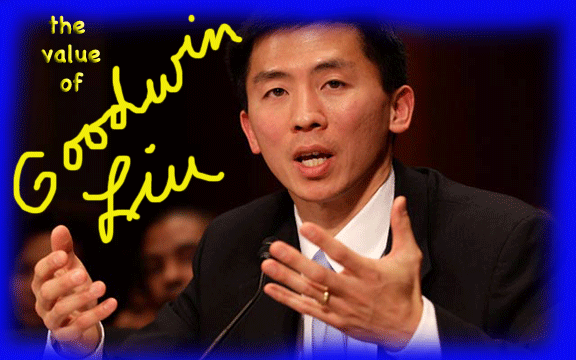
A trio of legal and justice stories that you shouldn’t miss:
THE SIGNIFICANCE OF JERRY BROWN’S APPOINTMENT OF GOODWIN LIU TO THE CALIFORNIA SUPREME COURT
In his Sunday column, the Sac Bee’s Dan Morain has an interesting take on why Governor Jerry Brown’s recent appointment of Goodwin Liu to the California Supreme Court is important—to him and to us.
Here’s how it opens. But read the whole thing, because Morain develops his thesis in steps.
Gov. Jerry Brown is trying to make amends for missteps he made in his youth.
Brown nominated Goodwin Liu to the Supreme Court last week, hoping he has found a justice in the mold of a giant in California’s legal history, Roger Traynor.
Like Liu, Traynor was a 40-year-old UC Berkeley law professor with limited courtroom experience when Gov. Culbert Olson appointed him in 1940. Brown’s father, Gov. Edmund G. “Pat” Brown, elevated Traynor to chief justice in 1964.
For three decades, Traynor was integral to a court that expanded civil rights and pioneered what are now basic concepts of civil law. In Brown’s view, Traynor is the most distinguished justice ever to serve this state……
THE MESS WE’RE IN: FIVE STEPS IN TRANSFORMING PRISON CULTURE
Law professor Lynn S. Branham is an expert in sentencing and incarceration policy, and has written a very interesting paper for the Indian on how to—not just reform—but transform the dysfunctional prison culture that we have in most states, but most notably in California.
Here’s a clip from the abstract:
…..the more fundamental question is whether prisons can be, not just improved, but transformed. Transformation in this context means deep and sustained changes in the ethos of those who work and live in prisons. That ethos would reflect at least four precepts: (1) hope as an imperative; (2) the viability of renewal; (3) the catharsis that attends personal responsibility and accountability; and (4) the duty and call, extending to prisoners and correctional employees alike, to respect human dignity.
This article rests on the proposition that such “culture busting” in prisons is possible and describes five key steps that need to be taken by each state and the federal government to effectuate the envisioned transformation in their prisons.
US IMMIGRATION LAW GOVERNING ASYLUM CUTS AGAINST THOSE THREATENED BY MEXICAN DRUG CARTELS
US asylum law was written during the cold war and was aimed mainly at people who were being persecuted by their government. However, now we have a whole new class of asylum seekers at our borders, mainly those fleeing the violence of the Mexican drug cartels.
This story in the El Paso Times explains the problem. Here’s a clip:
….To obtain political asylum, a person must prove that there’s a well-founded fear of persecution on account of the person’s race, religion, nationality, political opinion or membership in a particular social group.
An individual must also show that he is being persecuted by his government or that authorities in his country are unable or unwilling to protect the applicant from persecution by another group.
Former immigration attorney Edgar Holguin said the problem for many political asylum cases from Mexico is that current asylum law — contained in the Refugee Act of 1980 — was drafted to offer protection in a Cold War setting.
“What I tell my clients is that asylum law was designed to help people fleeing from the other side of the Iron Curtain,” he said. “It worked really well for people who were openly practicing Christian faith in a communist country. But in Mexico’s case, it’s difficult to pigeon someone into it. The law was written for a different era and different circumstances.”
San Francisco immigration Judge Dana Leigh Marks, head of the national immigration judges’ union, said that the law predates some of today’s problems, such as gangs in Guate mala and cartels in Mexico, so there are fewer precedents on how the law should be applied.
“These are newly emerging situations, so case precedents do not squarely address them,” she said.
While the law can be stretched to accommodate cases from foreigners seeking relief from gang or drug violence, such arguments often don’t fit traditional interpretations of the law, immigration experts said…..
(Thanks to my pal and immigration policy guru Dan Kowalski for the heads up on this story.)
Photo by Chip Somodevilla/Getty Images

Can you post the cite for Lynn Branham’s article? I am very curious to read it.
Thanks!
Hi Kim, here’s the link: http://papers.ssrn.com/sol3/papers.cfm?abstract_id=1895583
Thanks for flagging the fact that I neglected to include it above.